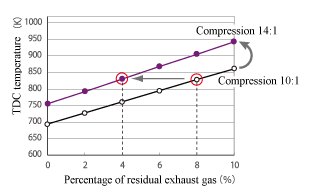Well, I've been thinking about layout and I have one setup in mind where it would be feasible change the secondary lengths by about 6" without too much trouble, just using clamps...
Thanks for the links, should make some good 'light' reading tonight

That's exactly what I'd expect from the reading I've done, if the EL header was reasonably well tuned for high RPM - the reflected pulses would arrive at precisely the wrong time at lower RPMS, pushing gas back into the cylinder instead of sucking it out, which would explain both lack of torque and extra knock (as per the autozine article on the Mazda SkyActiv manifold linked earlier):

Conversely if there's a bit of valve overlap and new header is scavenging less at high RPM, the ECU could be expecting a slightly larger larger air charge, and adding the right amount of fuel for the expected intake mass... though I'd expect closed loop control to correct that? It would depend on how closed 'closed loop' is, there may be saturation values in there which keep either internal or control parameters within predefined ranges - this is a common control systems 'hack' to stop a closed loop system from going unstable if some physical parameters change in an unexpected way

... depends on whether the person programming the ECS paid attention when they covered finding poles of a z-transform, and how much they expect the - and how much they trust the physical parameters of the system to not change. Of course, I'm no expert in ECS specifically, so I don't know whether that applies in this case.
When people talk about installing headers for performance, it's often mentioned that ECU tuning is required to get the best out of it... but I'm not sure if that's because they take it out of the closed loop parameter envelope, or